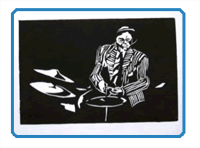
By Matt Fussell
Relief printmaking is a form of printmaking in which the image to be printed is raised from the surface. Pieces of material are removed from the surface using sharp tools called gouges. This creates a surface similar to a stamp. Special block printing ink is added to the raised surfaces with a roller called a brayer. Paper is placed on top of the surface and then either ran through a printing press or burnished using a wooden spoon or a baron. The result is a mirror image print of the block.
Relief printmaking requires the artist to think in reverse. Most of us are used to making dark marks onto light colored surfaces. This means that we usually "work" the areas that are shadowed. In relief printmaking, the artist must work the areas that are to be light. (This assumes that the printmaker is printing on white paper with black or colored ink.) The parts of the image that are to white must be removed from the surface of the material (linoleum, wood, or rubber), leaving the remaining areas to accept ink and be printed.
Relief prints are mirror images of the block. This means that if you must add words, type, or numbers- they must be printed in reverse.
Relief prints can be made using a variety of material. Linoleum, wood, and rubber blocks are used in most relief prints. Linoleum is easier to cut than wood. Because of this, linoleum is preferred among beginning printmakers- although many professionals also prefer linoleum. Linoleum allows the printmaker to easily make curved lines and is able to accept impressions from sharp objects.
The following video art lesson shows you the process of relief printmaking...
Here are some more art lessons that you may like...